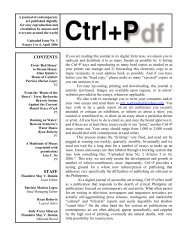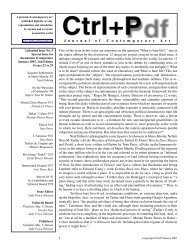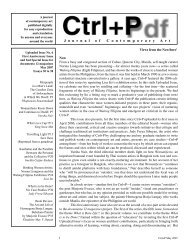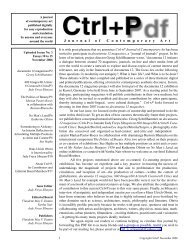Issue 15 - Pdf Ctrl+P - CTRL+P: a journal of contemporary art
Issue 15 - Pdf Ctrl+P - CTRL+P: a journal of contemporary art
Issue 15 - Pdf Ctrl+P - CTRL+P: a journal of contemporary art
Create successful ePaper yourself
Turn your PDF publications into a flip-book with our unique Google optimized e-Paper software.
Joselina cruz<br />
Signs <strong>of</strong> Wonder<br />
How can I not ask this: isn’t good laughter born from the<br />
“wonder <strong>of</strong> the event?”That is to say, the event where something is becoming<br />
and which <strong>of</strong>fers us the experience <strong>of</strong>, as Michael Serres would say, “the immense,<br />
sparkling, holy joy <strong>of</strong> having to think.” (Lomax, 2000, pxii)<br />
When I was asked to work on the second Singapore Biennale, all the missteps that I had<br />
seen and critiqued regarding the first, as well as the criticisms that surrounded biennales<br />
which I had shored up all these years came rushing to the fore. All the criticisms, especially<br />
that <strong>of</strong> the biennale being staged together with the International Monetary Fund<br />
meeting, were problems I was determined to resist and desist. The rate <strong>of</strong> my success in<br />
resistance was dismal.<br />
The circumstances <strong>of</strong> the curatorial team’s coming together was a highly balanced<br />
decision, with Fumio Nanjo’s continuation as <strong>art</strong>istic director, being an especially important<br />
key at giving the biennale the necessary steam to forge into the second. Nanjo-san<br />
was the epitome <strong>of</strong> the regional internationalist, with as many biennales tucked under<br />
his belt as the number <strong>of</strong> biennales that ran for that year throughout the region. Matthew<br />
Ngui was deeply respected by the Singaporean <strong>art</strong> community as both <strong>art</strong>ist and curator,<br />
having been p<strong>art</strong> <strong>of</strong> important international exhibitions (Documenta and Cities on the<br />
Move to name a few); these made him perfect for the post. Finally, I had some curatorial<br />
experience, I was also familiar with Southeast Asia as my specialisation and interest, and<br />
more importantly, I had previously worked in Singapore.<br />
With the Singapore Biennale 2008 (SB2008), I found myself with the opportunity<br />
to work on a new scale, and with more demanding parameters that had to be thought<br />
through more critically and more reflexively. Despite the intense 18 months that we<br />
worked on for the Biennale, the space for reflection is still only, ever, after the fact. The<br />
months before the biennale where marked by a relentless pace that seemed to be at the<br />
he<strong>art</strong> <strong>of</strong> the process. I was coiled within a machine wherein days rolled into weeks and<br />
weeks churned out months quickly. It was an appalling luxury to find myself immersed<br />
and sucked into becoming a mere cog <strong>of</strong> biennale-making. Rupture is a difficult strategy.<br />
And <strong>of</strong>ten a strategy that backfires when set within an ossified system. The platform <strong>of</strong><br />
a biennale is like that <strong>of</strong> a gelatinous substance. You see yourself and everyone else in<br />
place, but very few within can move except with labored motions. The biennale structure<br />
allows very few <strong>of</strong> its proponents the ability for true criticality without sacrificing the<br />
exhibitionary aspect <strong>of</strong> the enterprise. Despite Marian Pastor-Roces’s extolling Havana’s<br />
interesting position (which positioned itself as the Third World Biennale), Havana is<br />
still located within the confines <strong>of</strong> the biennale bind (“Crystal Palace Exhibitions” in<br />
Over Here, 2007). Biennales do not seem to have the ability to turn into itself and create<br />
self-reflexive exhibitions that continuously and successfully question the foundation on<br />
which it exists.<br />
Adding a layer to the difficulty <strong>of</strong> working within biennales is the fact that is Singapore.<br />
Singapore is a city with many troubling aspects underneath its shiny exterior,<br />
transparency being the least <strong>of</strong> its virtues. The structure <strong>of</strong> the city is framed strongly by<br />
its government, to quote:<br />
Singapore has constructed a veneer <strong>of</strong> democracy, development and<br />
freedom that largely insulate it from international criticism. While Singapore<br />
is a parliamentary democracy in name, the effectiveness <strong>of</strong> its democracy is<br />
undermined by the PAP’s rigorous controls over speech and the press.<br />
It is perhaps because <strong>of</strong> their economic prosperity that the people <strong>of</strong><br />
Singapore do not protest more at their exclusion from the political process.<br />
From a human rights stand point, however, the Western-style prosperity <strong>of</strong> the<br />
place makes denials <strong>of</strong> civil and political rights all the more <strong>of</strong>fensive. 1<br />
22 <strong>Ctrl+P</strong> September 2009







